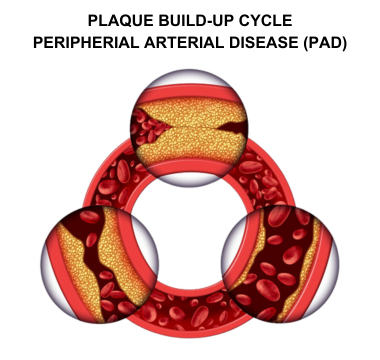Arterial Disease
Arteries play an important role in our overall health. They deliver oxygen-rich blood from the heart to other parts of the body. When plaque builds up, arteries can become weakened or diseased. Plaque acts as an internal roadblock in the arterial walls- restricting the flow of blood, oxygen & glucose. This “roadblock” causes pain in the leg because muscles and tissues are being starved of oxygen and other essential nutrients.
Your health is our priority.
Contact us today.
What Is Arterial Disease?
The arteries and veins are collaboratively known as the vascular system. They work with your heart to ensure that your body’s organs & tissues are getting the nutrients they need. Arteries carry oxygenated, nutrient-rich blood away from the heart and deliver it to the body. Veins take used, poorly oxygenated blood back to the heart, where it is cleaned & redistributed by the arteries again. Your body depends on this seamless cycle to cleanse organ tissues of waste and sustain a healthy lifestyle
If these blood vessels are open and clear, blood can flow optimally. However, arteries and veins can weaken or become damaged overtime, making it extremely difficult for them to move blood throughout your body.

Plaque buildup can create blockages that hinder the arteries from distributing fresh
blood to your body’s organs & tissues. If your tissues aren’t receiving the nutrients
they need, arterial disease can develop.
Peripheral arterial disease, for example, occurs when plaque accumulates in the lower extremities. This condition is not only dangerous
and life-threatening, but also extremely common. 1 in 5 patients over the age of 60 suffer from PAD. If left untreated, PAD can lead to
non-healing wounds, gangrene, and limb amputation.
PAD puts patients at risk for serious heart-related health conditions such as heart attack, stroke, and other arterial diseases like
coronary artery disease (CAD)
Arterial Disease Symptoms
The symptoms associated with arterial disease can vary depending on which area of the body has been affected.
For example, chest pain is common with arterial conditions like a thoracic aortic aneurysm or coronary artery disease as these conditions occur in the chest.
Leg pain, on the other hand, is typically seen with peripheral arterial disease as this condition occurs in the lower extremities, such as the legs, feet, & ankles.
Some common symptoms of Peripheral Arterial Disease (PAD) are:
- Cramping in your legs
- Weakness or numbness in your legs
- Weak pulse in your feet or legs
- Restless legs
- Loss of hair around the ankles
- Numbness or coldness in your feet
- Open wounds or ulcers on your feet
- Change in the color of your feet
- Pain in feet or toes while resting
- Slower toenail growth
Common Types Of Artery Disease
PAD develops when there is an excess of plaque buildup on the artery walls, causing the arteries to narrow. Arteries deliver oxygen-rich blood from the heart to other parts of the body. When plaque builds up, it acts as an internal roadblock in the arterial walls – restricting the flow of blood, oxygen & glucose. This “roadblock” causes pain in the leg because muscles and tissues are being starved of oxygen and other essential nutrients.
The carotid arteries are the two large blood vessels located on either side of the neck. They supply fresh blood to the front part of the brain. Carotid artery disease (CAD), also called carotid artery stenosis, occurs when the carotid arteries begin to narrow. Narrowed blood vessels are caused by atherosclerosis, an excessive buildup of plaque within the walls of the blood vessels.
The renal arteries supply blood to the kidneys, which filters waste from the body. Much like the body’s other arteries, the renal arteries can become narrowed and stiff with plaque buildup. When this occurs, optimal blood flow cannot reach the kidney, ultimately resulting in renal vascular disease.
Coronary artery disease occurs when the coronary arteries become weakened or diseased with plaque buildup. Narrowed blood vessels are caused by atherosclerosis, which is a term for excessive plaque buildup within the walls of the blood vessels. Overtime, this plaque can harden, creating a blockage that hinders blood from traveling to the heart.
An aortic aneurysm occurs when the aorta, the primary blood vessel that distributes blood throughout the body, enlarges. Also known as an AAA, an abdominal aortic aneurysm occurs at the abdomen as the aorta swells.
The section of the aorta that runs through the chest is called the thoracic aorta. When the walls of the aorta are weakened or deteriorated, it can begin to bulge. Eventually, this balloon-like bulge can rupture, leading to an aortic aneurysm. An aneurysm can happen anywhere in the body. However, an aneurysm that occurs in the chest is known as a thoracic aortic aneurysm.
Why Monterey Bay Vascular?
At Monterey Bay Vascular, we offer coordinated care to prevent, diagnose, and treat vascular disease.
We understand, everyone deserves to live a long, happy life. Vascular disease may lead to limb loss and other life-threatening conditions such as pulmonary embolism. Our licensed vascular surgeon uses state-of-the-art tools and technology to tackle all problems related to your vascular system. Thanks to our vast wealth of experience, we also work with our patients to develop a unique solution that fits your needs. Contact us today to learn more about the vascular treatments we offer and schedule an appointment today!